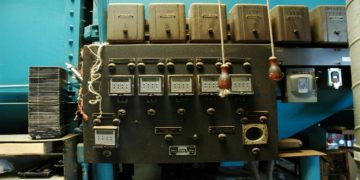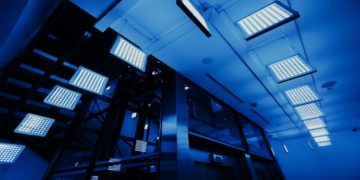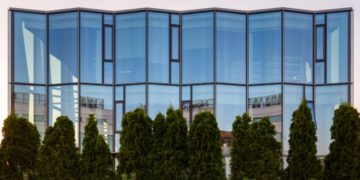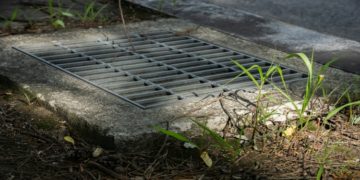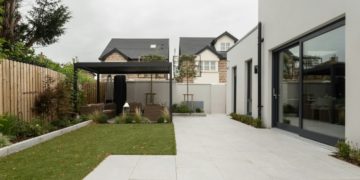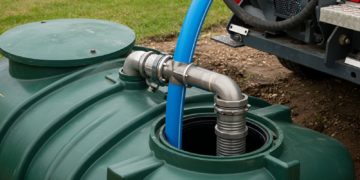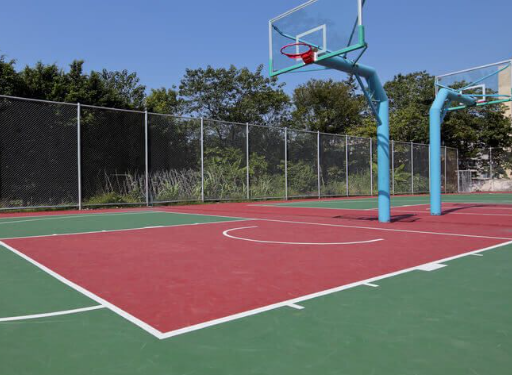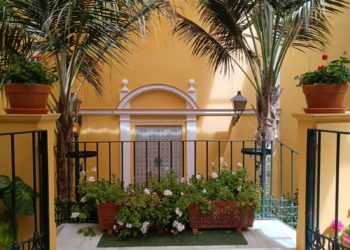When it comes to designing a basketball court, the surrounding fence is most often an afterthought, yet its presence is so vital to the workable nature of the space. However, in reality, the proper basketball court fence sets the perimeter of the facility and guarantees the protection of players, spectators, and neighboring properties. Despite continuous hits from balls, the fencing must allow visibility to foster a positive atmosphere; if the aesthetics allow, this can be a plus. In this article, we will delve into some significant characteristics of basketball court fencing, the advantages they bring, and some hints that will help you in making a well-informed decision regarding this important aspect of court design. Whether constructing a new court or upgrading an existing one, knowing fencing is essential in providing a safe, durable, and professional-grade appearance. If you are looking for more information about Basketball Court Fence – Dingdian go here right away
Types of Fences for Basketball Courts
Chain-Link Fences
Due to their durability, cost-effectiveness, and minimal maintenance required, chain-link fences are a type of fencing most commonly used for basketball courts. They provide good viewing for spectators to enjoy their games and also effectively keep the balls inside the court. Another notable characteristic of chain link fencing is that it withstands various weather conditions well and can be constructed to any desired height.
Steel Fences
Steel fences provide additional strength and durability over chain-link types and are highly resistant to impact so as to serve well in front of heavy usage of the court, maybe in a public setting. They may prove expensive initially; hence a bit expensive maintenance-wise.
Mesh Fences
Mesh fences are engineered to offer durability along with a sleek, modern look. If players or balls come into contact with the fence, it provides a softer impact, resulting in less noise and potentially helping to prevent injuries. Most mesh materials are coated for both anti-rust protection and long-term beauty retention.
Welded Wire Fences
Welded wire fences are a relatively inexpensive choice for creating a good-looking and secure environment. Their stiff structure makes this fence very sturdy and resistant to tampering, while its closely spaced wires provide a neat appearance. These fences are best suited for private or high-grade facilities.
Chain Link Fences
Chain link fences are flexible and inexpensive for enclosing sports courts. With interwoven steel wires, chain-link fences offer durability, flexibility, and dependable containment. The open-weave design provides superior visibility and air circulation, making it ideal for various court applications. Chain link fences are coated with materials such as galvanized zinc or vinyl to resist rust and inclement weather. While not as rigid as welded wire, they are simpler to erect, repair, and modify for courts of various dimensions, thus providing the combination of affordability, utility, and convenience that render chain link fences most popular for both recreational and professional establishments.
Mesh Fencing Options
Mesh fencing variations comprise a variety of materials and design options, depending on the requirements and applications. Common types are welded wire mesh, appreciated for its rigidity and long-lasting durability, and chain link mesh, appreciated for its flexibility and cost-efficient installation. These fences are often coated in vinyl or galvanized zinc in order to prevent corrosion and enhance their longevity. Further, mesh fences are available in various densities and gauges. This allows users to select the configuration that best fits their security, visibility, or aesthetic needs. These customizable properties make mesh fencing suitable for residential, commercial, and industrial purposes.
Customizable Vinyl Fencing
Versatile vinyl fencing fits many roles as a durable solution. Export quality polyvinyl chloride (PVC) is the primary ingredient for generating ultimate protection against adverse weather conditions and eventual fading. Hence, this product is low in maintenance. They come in innumerable styles, colors, and textures, so users can pick the fencing to fit their requirements either for privacy, aesthetic embellishment, or boundary definition. Vinyl fencing customization also extends to height and panel design so that installations can meet local regulations or personal preferences. This resistance to pest invasion, rotting, and corrosion also helps improve its life, making it a worthwhile investment for residential and commercial purposes.
Benefits of Basketball Court Fencing
Basketball court fencing offers several fundamental benefits related to safety, functionality, and durability. Controlling the direction of ball throws, the fences prevent balls from leaving the court, thereby reducing the risk of injury to bystanders and interruptions to the activity. Defining the space of this basketball court with clear boundaries initiates an enclosed area ready for organized play. Weather resistance and longevity must be guaranteed through the use of high-quality materials in their construction, rendering them suitable solutions for both indoor and outdoor courts. Proper fencing enhances the overall experience and maintenance takes little effort as time passes.
Enhanced Safety and Security
Proper fencing systems are essential in preserving safety and security as they confine activities to within the set parameters of the court, therefore rendering unauthorized access impossible. Maintenance of appropriate levels of mesh security is usually provided by tightly meshed steel or resistant polymer composites, thus presenting an extrinsic danger to would-be intruders that is nearly impossible to overcome. Such fencing is also important for preventing introductions of stray injuries in sports where the court sees heavy traffic, and the equipment arena is another venue for such injuries. Additionally, fencing installed according to height requirements and with secure locking provisions will protect against inadvertent intrusions and safeguard the equipment and infrastructure at the courts. Through contemporary design applications such as visibility-optimized mesh or padded barriers, the fencing fortifies the perimeter without compromising on creating a secure, controlled athletic environment, further mitigating liability concerns and improving the user experience.
Privacy Screen Fences
Privacy screening fences offer a valuable addition to sports courts, providing several benefits, including enhanced privacy, reduced distraction, and wind protection. Made from durable, woven materials, these screens can withstand outdoor conditions while maintaining their integrity over time. They simultaneously block visibility from outside, providing a less distracting and more comfortable environment for sports activities. These privacy screens also diminish wind interference, ensuring game performance suffers less from environmental factors. Installation is relatively straightforward as these screens can be fastened to existing fencing structures, making them an ideal practical solution for facility managers looking to ramp up both functionality and aesthetics.
Complementing the Outdoor Basketball Court
One way to complement the outdoor basketball courts is by installing durable and weather-resistant court markings that stay clear throughout all weather changes. The other are lighting of high quality that extend functionality into the evening, protective coverings such as retractable canopies to shield against weather and UV rays, while seating areas furnished with comfortable benches and shade structures enhance spectator experiences. Eco-friendly drainage systems can prevent waterlogging and help keep the court performing optimally and safely. Together, the above improvements make a well-packed whole, one of preferred function and convenience for both players and spectators.
Installing a Basketball Court Fence
There is nothing more significant in creating a safe space that also maintains its functionality and enhances the experience of both players and spectators than having a basketball court fence installed. The well-maintained fence effectively keeps the ball within the play area, minimizing interruptions and accidents. Additionally, it serves as a safety barrier between the properties, protecting anyone along the way from potential damage. A design that uses weather-resistant materials like galvanized steel or chain-link with an appropriate coating is preferable for any fence due to prolonged exposure to environmental elements. Its height, along with its access gates, also controls entry and restriction effectively. A basketball court fence, therefore, eventually acts as one of the basic features that give more professionalism and functionality to the facility.
Choosing the Right Materials
It is important for the materials used in building a basketball court fence to be strong, weather-resistant, and easy to maintain. Galvanized steel and vinyl-coated chain link are mostly preferred because of their ability to withstand severe weather without rust and corrosion. These materials also require very little maintenance, so they will last for a long time practically without further upkeep. For areas in high winds, consideration should be given to stronger posts and fittings. In terms of budget, selections must satisfy both the safety requirements of the locality and the aesthetic needs. Therefore, in choosing excellent materials, the security and operation of the fence will be guaranteed for a long time.
Installation Process Overview
The first step in the installation process is site preparation, which involves clearing any obstructions, setting out boundaries, and ensuring the ground is level. There is then the setting out and marking of the posts’ position and disposition to ensure proper alignment and spacing relative to the fence design. Thereafter, one digs the holes of suitable depth, taking into account the depth of good soil as well as the local conditions, and the posts are fixed with concrete, which affords greater durability. After the posts have sufficiently cured, the next step is to fix the fencing material, which can be panels, rails, or mesh, using reinforced fixings to install a sturdy structure. After that, the installation will be checked for structural integrity to ensure it complies with safety standards, followed by any necessary adjustments to achieve a professional finish. The entire process of conducting site visits to evaluating completed constructions, which satisfy the required quality standard, takes approximately one week.
Considerations for Residential Spaces
Among the many factors to consider when planning for fencing in residential spaces are those related to functionality, aesthetics, and local codes. The purpose for erecting the fence must be very well defined, which could include privacy, security, or merely decorative. Material selection is essential because it benefits durability, maintenance needs, and appearance. Whether it is wood, vinyl, aluminum, or composite materials, it should be a matter of careful deliberation, as each has its own pluses and minuses. The height and design of the fence must comply with any neighborhood zoning restrictions or homeowner association policies to avoid creating legal issues. Site preparation is vital to clear the ground of all unevenness, underground utilities, drainage issues, and other factors that may affect the structural integrity of the fence in the future. Other considerations would include treating or coating the fence in the future to prolong its life and ensuring that the installation complements the property’s architectural style for greater aesthetic appeal.
Fencing for Other Sports Courts
Since the primary criteria for sports court fence selection are safety, durability, and functional application, chain-link fences are frequently applied for their strength and ability to keep balls in the court, thereby ensuring minimal interruptions. Windscreens can be used on fences to reduce noise and maintain privacy in the environment. The height of the fence should be adapted to specific sports, allowing it to meet regulations while still providing unobstructed views for spectators. Only the proper installation and reasonable maintenance of the fence guarantee durability and proper functioning.
Tennis Court Fencing
Fencing tennis courts is both a safety and a functional matter, as it ensures the containment of balls while also being appropriately visible for players and spectators. Chain-link fencing is commonly installed to resist high-impact forces over a typical period, thereby ensuring durability and sufficient tensile strength. To lessen noise and provide visual privacy, windscreens may be tightly attached to the fence structures. The height of the fence can vary with regulations, but is generally between 10 and 12 feet to prevent balls from escaping from the fence, yet preserving a clear line of sight. Proper installation methods should employ corrosion-resistant hardware and well-anchored posts; these should be maintained through regular inspections and proactive maintenance to prolong the longevity and ensure consistent performance of the fencing system.
Baseball Backstop Options
Selecting a baseball backstop involves considering factors related to materials, size, and design. Chain-link fence, mesh netting, or a mixture of both serve as standard options, providing varying degrees of durability and visibility. Chain-link backstops are composed of galvanized steel or PVC-coated materials and are highly durable, making them suitable for permanent installations. Mesh netting, on the other hand, enhances visibility and is typically composed of premium synthetic fibers, such as polyethylene or nylon, used primarily for portable or semi-permanent applications. The designs may be as simple as a straight-back style or a more elaborate canopy model that effectively traps foul balls. When weighing these options according to the requirements of durability, ease of installation, and budget, the right backstop design can be chosen to offer the best performance and safety.
Pickleball Court Enclosures
Pickleball court enclosures are constructed to maintain safety, maximize playability, and maintain the integrity of the court area. Such enclosures are typically built with heavy-duty materials, such as galvanized steel fencing or high-tensile netting, to withstand impacts and the elements. A standard height for these enclosures ranges between 10 and 12 feet, which effectively prevents balls from leaving the court area while also complying with regulations. Portable options made from lightweight yet strong mesh material for temporary setups also exist. When selecting an enclosure, the court dimensions, intended use, and local zoning regulations should all be considered to ensure the enclosure is suitable and compliant. This consideration sets a solid foundation for the safe and efficient working environment expected of a pickleball program.
Decorative and Functional Features
Decorative and functional elements in the construction of pickleball court enclosures serve to beautify and enhance the [buyers market]. Typical decorative elements allow significant leeway for paint schemes, cladded signs, or landscaped borders; such features lend a classy and professional touch. Functionally, one’s enclosure should be outfitted with windbreaks, visibility panels, or adjustable entry gates to provide comfort for play and ease of entry. Protective coatings against weather and reinforced materials go a long way toward guaranteeing prolonged existence while preserving the aesthetics. By combining decorative enhancements with practical functionalities, enclosures can effectively address the concerns of both players and facility operators.
Fence Screens for Aesthetic Appeal
Fence screens serve as a versatile solution for beautifying an enclosure, offering the added benefit of functionality. The screens can boast a wide range of colors, patterns, or materials chosen best to complement either the local environment or branding requirements. Besides the decorative purpose, they carry practical benefits such as privacy from unwanted view, reduction of wind interference, and distractions to the players. In general, the finest fence screens take it one step further by being made from fabrics that are both UV-resistant and waterproof, thereby combining aesthetic value with durability under constant exposure to weather conditions. The use of fence screens allows for the combination of style and functionality, satisfying specific design and performance criteria.
Grommet Weave Fencing
Grommet-weave fencing provides an innovative solution designed to enhance both the durability and ease of installation of fence screens. The grommets are purposely integrated into the reinforced edges of the screen at regular intervals, typically every 12 to 24 inches, allowing fasteners such as zip ties or heavy-duty hooks to be attached securely. This method of construction reduces fabric stress, which would otherwise tear or sag over time and in heavy tension or adverse weather conditions. Additionally, the grommet weave method allows more air to pass through the screen, thereby improving wind resistance and overall stability. Built from the finest materials available and crafted with meticulous attention to detail, grommet weave fencing stands as a long-term, trusted choice for facility operators seeking to preserve privacy and functionality amid environmental challenges.
Combining Functionality with Design
The grommet weave technique is one of those rare techniques that combines elements of function with beauty. The careful weaving technique ensures durability and structural integrity, whilst the precision craftsmanship creates a visually pleasing fencing. By allowing the screening material to breathe, it tangibly prevents wind damage and at the same time achieves a stylish, professional appearance that can fit into several user profiles. Being both resilient and pleasing to look at, grommet weave fencing offers a solution for facilities that value both functionality and style equally.
Frequently Asked Questions (FAQs)
What Are the Benefits of a Basketball Court Fence?
Basketball court fencing offers numerous benefits, including enhanced safety and improved playability. The fencing provides a secure environment that prevents stray balls from moving into adjacent areas, which is highly appreciated in residential settings. Since the fencing is part of a multipurpose feature, it enhances the appearance of your sports facilities when positioned alongside your outdoor basketball court. From heavy iron to vinyl solutions that can be customized to suit a specific design, fencing options are quite versatile to meet your particular needs. Healthier fences maintain their usefulness for many years and therefore seldom require replacement.
How to Install a Basketball Court Fence?
A basketball court fence installation involves several steps to ensure the fence serves its intended purpose and looks aesthetically pleasing. First, make measurements of your court, select the locking material, and pick its design. Ornamental iron or vinyl of heavy grading are among the popular choices available. Online, numerous resources are available for those who prefer a do-it-yourself approach, which may include setting up posts, hanging panels, and ensuring everything is securely locked. Being mindful of surface areas and incorporating some customization will ultimately enhance the beauty and functionality of your fence. Alternatively, if you prefer to take the easy way out, you can always schedule an appointment with a reputable company like Courts Unlimited.
What Type of Fence Is Best for a Basketball Court?
The best fencing for a basketball court will largely depend on what needs the installation is supposed to fulfill. When considering security and durability, heavy-duty options such as iron fences may come to mind. However, for lighter maintenance, vinyl fences can be a viable alternative, offering customization options in terms of height and color. Other alternatives also include mesh fences, which are considered quite good by the standard of visibility, to keep errant balls and watch games. Considering residential installations, a fence with a privacy screen could also be a viable option, function-wise. Ultimately, the choice should align with one’s recreational pursuits and the surrounding environment of the court.
Can I Create a DIY Basketball Court Fence?
Indeed, it is possible to build a DIY basketball court fence, provided that you possess some handyman skills. First, research the different materials and designs that best suit the specific needs of your court, whether that means a garden fence or something more robust. Gather all your tools and be clear in your plan, including measurements and layout. While building the wall, consider incorporating grommets to hold netting, as this will enhance the fence’s utility. If properly executed and well-planned, a DIY fence can be an effective way to supplement the alternative installation of your outdoor basketball court.
How Does a Basketball Court Fence Enhance Recreation?
With a basketball court fence, the recreational experience is greatly enhanced by providing an enclosed area where athletes can practice. This keeps stray balls from interrupting activities nearby, such as on a baseball field or a tennis court. Meanwhile, it fosters a more focused and enjoyable atmosphere for playing. The enclosure allows for uninterrupted play, making it great for family or community events. The design of the fence can also contribute to the beautification of the area, thereby providing a sudden motivation for residents to engage in recreational activities. With the best investment, your court will undoubtedly remain a focus of fun and fitness.


